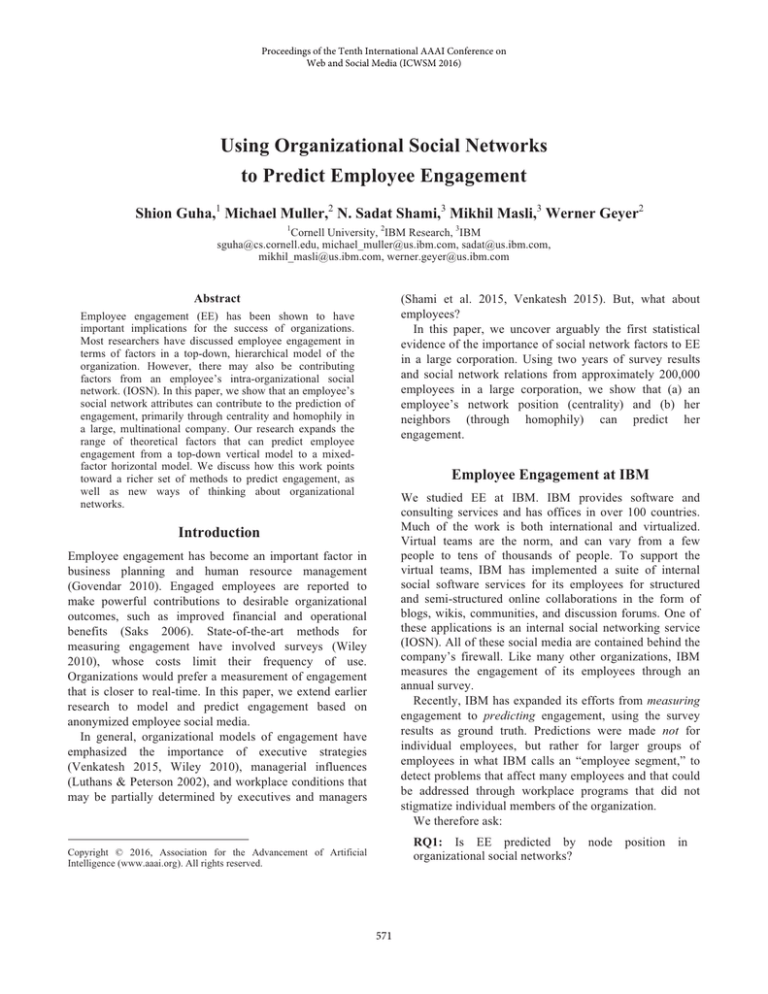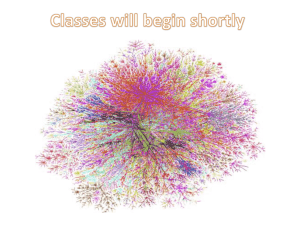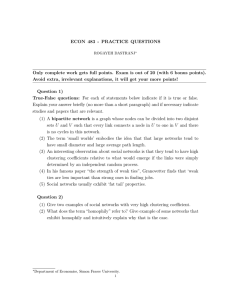
Proceedings of the Tenth International AAAI Conference on
Web and Social Media (ICWSM 2016)
Using Organizational Social Networks
to Predict Employee Engagement
Shion Guha,1 Michael Muller,2 N. Sadat Shami,3 Mikhil Masli,3 Werner Geyer2
1
Cornell University, 2IBM Research, 3IBM
sguha@cs.cornell.edu, michael_muller@us.ibm.com, sadat@us.ibm.com,
mikhil_masli@us.ibm.com, werner.geyer@us.ibm.com
(Shami et al. 2015, Venkatesh 2015). But, what about
employees?
In this paper, we uncover arguably the first statistical
evidence of the importance of social network factors to EE
in a large corporation. Using two years of survey results
and social network relations from approximately 200,000
employees in a large corporation, we show that (a) an
employee’s network position (centrality) and (b) her
neighbors (through homophily) can predict her
engagement.
Abstract
Employee engagement (EE) has been shown to have
important implications for the success of organizations.
Most researchers have discussed employee engagement in
terms of factors in a top-down, hierarchical model of the
organization. However, there may also be contributing
factors from an employee’s intra-organizational social
network. (IOSN). In this paper, we show that an employee’s
social network attributes can contribute to the prediction of
engagement, primarily through centrality and homophily in
a large, multinational company. Our research expands the
range of theoretical factors that can predict employee
engagement from a top-down vertical model to a mixedfactor horizontal model. We discuss how this work points
toward a richer set of methods to predict engagement, as
well as new ways of thinking about organizational
networks.
Employee Engagement at IBM
We studied EE at IBM. IBM provides software and
consulting services and has offices in over 100 countries.
Much of the work is both international and virtualized.
Virtual teams are the norm, and can vary from a few
people to tens of thousands of people. To support the
virtual teams, IBM has implemented a suite of internal
social software services for its employees for structured
and semi-structured online collaborations in the form of
blogs, wikis, communities, and discussion forums. One of
these applications is an internal social networking service
(IOSN). All of these social media are contained behind the
company’s firewall. Like many other organizations, IBM
measures the engagement of its employees through an
annual survey.
Recently, IBM has expanded its efforts from measuring
engagement to predicting engagement, using the survey
results as ground truth. Predictions were made not for
individual employees, but rather for larger groups of
employees in what IBM calls an “employee segment,” to
detect problems that affect many employees and that could
be addressed through workplace programs that did not
stigmatize individual members of the organization.
We therefore ask:
Introduction
Employee engagement has become an important factor in
business planning and human resource management
(Govendar 2010). Engaged employees are reported to
make powerful contributions to desirable organizational
outcomes, such as improved financial and operational
benefits (Saks 2006). State-of-the-art methods for
measuring engagement have involved surveys (Wiley
2010), whose costs limit their frequency of use.
Organizations would prefer a measurement of engagement
that is closer to real-time. In this paper, we extend earlier
research to model and predict engagement based on
anonymized employee social media.
In general, organizational models of engagement have
emphasized the importance of executive strategies
(Venkatesh 2015, Wiley 2010), managerial influences
(Luthans & Peterson 2002), and workplace conditions that
may be partially determined by executives and managers
RQ1: Is EE predicted by
organizational social networks?
Copyright © 2016, Association for the Advancement of Artificial
Intelligence (www.aaai.org). All rights reserved.
571
node
position
in
Variable/Year
Total number of links
Total number of nodes
Variable
Min
Degree*
Eigenvector*
Clustering Co-efficient*
0
0
0
2013
5,535,846
209,471
Max
Mean
Std. Dev
Min
1
0.452
0.033
0
1
0.347
0.081
0
1
0.293
0.036
0
*all centrality metrics have been normalized
Max
2014
5,951,165
219,138
Mean
1
1
1
0.476
0.392
0.377
Std. Dev
0.038
0.089
0.045
Table 1. Descriptive Statistics of the IOSN across both years of analyses
inclusion of eigenvector centrality to measure the relative
influence of the position of a node for large, complex
networks, while degree centrality is a simple measure of
the number of friends of a particular node. Similarly, we
chose the clustering co-efficient since prior work (Newman
2001) established that social networks exhibit a
phenomenon of clustering based on preferential attachment
of nodes. We note that feature selection of the optimum set
of network centrality metrics for any given network is a
separate, future research project and outside the scope of
this particular report.
Second, consistent with current IBM practices (Wiley et
al. 2010), we converted the mean score of the three survey
items to a binary variable, where mean scores in the range
4-5 (inclusive) were coded as 1 (engaged) and mean scores
below 4.0 were coded as 0 (unengaged). This was our
ground-truth dependent variable.
RQ2: Is EE predicted by homophily in organizational
social networks?
Methods
Data Sources
We combined three large workplace datasets:
•
A social network of friendship relationships, recorded from
IBM’s social networking service (IOSN). We discuss this
network in the formal language of social network analysis,
where people are “nodes” and friend relationships are
“edges” that connect nodes. To protect employee privacy,
all identities were anonymized through non-reversible MD5
transformation.
•
Demographic data for each employee, provided by IBM’s
human resources organization, and anonymized in the same
way as above. These data included locations, organizations,
and human resources historical data such as time-in-title and
performance ratings.
•
Survey data from two years of EE surveys, provided by the
human resources organization, and anonymized in the same
way as above. As described above, the survey used three
core questions that address pride, satisfaction, and advocacy
(likelihood to recommend IBM as a good place to work).
Variables and Measurements
Salary Group: IBM has an internal grouping system for
employees in different salary groups. This consists of 15
levels and is an ordinal variable.
Performance Review: IBM also has an internal system
of rating employees. This consists of 5 levels and is also an
ordinal variable.
Time since Last Promotion: This represents the time (in
months) since the employee was last promoted at work.
Tenure in the Company: This represents the time (in
months) that the employee has been employed at the IBM.
Age: This represents the biological age (in years) of an
employee.
Gender: This is a binary variable (male=0/female=1) of
an employee’s gender. IBM did not provide alternative
options to express gender.
Degree centrality: This is a normalized (range = (0, 1))
measure of the number of nodes that a particular node is
connected to in the IOSN. (Seidman 1983)
We used the MD5-anonymized employee IDs to align
these records. Our resulting dataset contained records for
209,471 employees for 2013 and 219,138 employees for
2014.
Preprocessing
We performed two pre-processing steps. First, we
calculated several network centrality metrics from the
edge-list data to determine the degree of importance of
each node (employee) in the IOSN. There are many
network centrality metrics; we chose three that we felt best
encapsulated the connectedness and importance of a node
in our IOSN. Bonacich (Bonacich 2007) recommended the
572
Year
2013
Variables
Std. β
2014
OR
SE
Std. β
OR
SE
Salary Group
0.11
0.8
0.023
0.06
1.165
0.013
Performance Review
0.09
1.107
0.016
-0.12
1.248
0.028
Time since Last Promotion
- 0.06*
0.859
0.018
-0.09*
0.556
0.018
Tenure in the Company
- 0.14*
0.963
0.024
-0.12*
0.896
0.031
Age
-0.12*
0.717
0.033
-0.13*
0.834
0.022
Gender
- 0.03
0.952
0.014
-0.04
0.914
0.009
Degree
0.11**
1.118
0.001
0.07
1.106
0.002
Eigenvector
0.26***
1.614
0.016
0.28***
1.729
0.019
Clustering Co-efficient
0.09
1.031
0.021
0.19**
1.265
0.017
Model Fit Statistics
AIC = 3142
BIC = 2692
AIC = 3318
BIC = 2958
*** p < 0.001 ** p < 0.001 * p< 0.05
Table 2. Results of the Logistic Regression Model for each of 2013 and 2014.
Eigenvector centrality: This is a normalized (range = (0,
1)) measure of the relative influence of a node, given its
position and connectivity in the IOSN. (Bonacich 2007)
Clustering Co-efficient: This is a normalized (range =
(0, 1)) measure of how well a node tends to cluster together
with immediate neighbors (Watts & Strogatz 1998)
as well as P(EE) for each respective year of analysis (2013
and 2014) after 10 fold cross validation is presented in
Table 3.
Results and Discussion
Table 1 lists summary statistics describing the major
properties of the IOSN across both years (2013, 2014). We
can get a holistic idea of the structure and size of the IOSN
across both years. Comparing the 2013 and 2014 networks,
we observed a net increase of 415,319 edges (friend
relationships) and 9667 nodes (employees) in the IOSN.
Analysis
First, we used binary logistic regression to estimate the
effect on engagement of an individual given her node
position and demographical attributes. These results are
presented in Table 2. Second, we estimated a social
network-based effect by performing a homophily-influence
analysis (Ibarra 1992).Therefore, for each node p we
compute the probability of a net homophily effect for
engagement from all her neighbors as follows:
Individual Level Effects (RQ1)
Demographics, in both years, explain roughly 50% of the
overall variance. A close inspection of all the demographic
variables starts to reveal a picture of an ideal engaged
employee. This hypothetical employee has been with the
organization for a short period of time (1-3 years), earns a
mid-level salary, was promoted less than a year ago, and
usually receives a high performance review. Altogether,
this suggests that EE at IBM is driven only partly (~50% of
explained variance) by demographic and other workplace
related factors. Our question then becomes: can we
improve on this prediction by adding network centrality
metrics to our predictors? RQ1 predicted that node
position in the network would be an important predictor of
EE. In 2013, degree centrality and eigenvector centrality
were significant predictors in this model. This result points
towards an intuition that employees arrange themselves in
specific ways in this IOSN to achieve their enterprise
objectives. This situation slightly changes in 2014, where
where:
n = total number of neighbors
u = total number of engaged neighbors
v = total number of disengaged neighbors
c = total number of common demographics with p
t = total number of demographic groups
n=u+v
Thus, the overall prediction of engagement for a given
individual (I) as well as network (N) effects is computed
by:
To assess these predictions, we compared correct
predictions vs. incorrect predictions via confusion
matrices. The confusion matrix for the computation of P(I)
573
Year
0
Predicted
1
Year
0
Predicted
1
Confusion Matrix Before Network Effects
2013
Observed
0
1
38,819
36,421
0
(44.9%)
(31.4%)
Predicted
47,637
79,569
1
(45.1%)
(69.6%)
Confusion Matrix After Network Effects
2013
Observed
0
1
47,896
26,330
0
(55.4%)
(22.8%)
Predicted
38,560
89,660
1
(44.6%)
(77.3%)
2014
Observed
0
35,414
(46.2%)
41,239
(43.8%)
1
39,716
(27.9%)
102,637
(72.1%)
2014
Observed
0
41,928
(54.7%)
34,725
(45.3%)
1
28,752
(22.2%)
113,601
(79.8%)
Table 3. Confusion Matrices before and after Network Effects
eigenvector and clustering co-efficient are the significant
network centrality predictors. This suggests two outcomes
of interest: First, relative node position is important in the
IOSN. Second, the tightness of node connections is equally
important.
for providing friend lists data.
References
Simon L. Albrecht (2010). Handbook of employee engagement:
Perspectives, issues, research and practice. Edward Elgar,
Cheltenham, UK.
Phillip Bonacich. (2007) "Some unique properties of eigenvector
centrality." Social Networks 29.4, 555-564.
Borgatti, S and Foster, P. (2003). The network paradigm in
organizational research: A review and typology. Journal of
Management 29(6), 991-1013.
Eean R. Crawford, Jeffrey A. LePine, and Bruce Louis Rich
(2010). Linking job demands and resources to employee
engagement and burnout: A theoretical extension and metaanalytic test. J. App. Psych. 95(5), 834-848.
Herminia Ibarra. (1992). "Homophily and differential returns: Sex
differences in network structure and access in an advertising
firm." Administrative science quarterly, 422-447.
Fred Luthans and Suzanne J. Peterson (2002). Employee
engagement and manager self-efficacy. J. Mgmt. Dev. 21(5), 376387.
Mark E.J. Newman. (2001). "Clustering and preferential
attachment in growing networks." Physical Review E 64.2,
025102.
Alan M. Saks (2006). Antecedents and consequences of employee
engagement. J. Mgmt. Psych. 71(7), 600-619.
Stephen B. Seidman. (1983) "Network structure and minimum
degree." Social networks 5.3, 269-287.
N. Sadat Shami, Michael Muller, Aditya Pal, Mikhil Masli, and
Werner Geyer (2015). Inferring employee engagement from
social media. Proc. CHI 2015, 3999-4008.
A. Narasima Venkatesh (2015). Employee engagement through
leadership. Am. Int. J. Res. Hum. Arts, Soc. Sci. 9(4), 333-336.
Duncan J. Watts, and Steven H. Strogatz. (1998) "Collective
dynamics of ‘small-world’networks." nature 393.6684, 440-442.
Jack W. Wiley (2010). The impact of effective leadership on
employee engagement. Empl. Rel. Today 37(2), 47-52.
Network Level Effects (RQ2)
In the 2013 IOSN, we find that the addition of homophilic
influences to individual level effects increases predictive
power of true positives by 8.3% and true negatives by
10.5%. Similarly, in the 2014 IOSN, we find the predictive
power of true positives increased by 7.7% and true
negatives by 8.5%. These are important points to note for
two reasons. First, these increases are moderately high and
second, they are in line with effect sizes in existing work
(McPherson et al. 2001) arising from homophily. This
gives us a relatively high degree of confidence that
homophily (or social selection) is an important predictor in
estimating EE in IBM. In other words, how you choose
your friends in your IOSN matters significantly towards
your EE.
RQ2 asked if homophily in IOSNs has some influence
on EE. Our homophily analysis suggests that indeed,
similarity among neighbors in IOSNs affects EE
significantly. The existence and increase in homophily, in
significant amounts, could also be one explanation of the
statistical significance (Newman & Park 2003) of the
clustering co-efficient metric that we found in Table 2. We
believe that, in the context of estimating EE, this is a novel
and important finding in the organizational network
literature which we discuss in greater detail in the next
section.
Acknowledgment
We acknowledge the anonymous reviewers and chairs for
their reviews as well as Inbal Ronen and Naama Zwerdling
574






